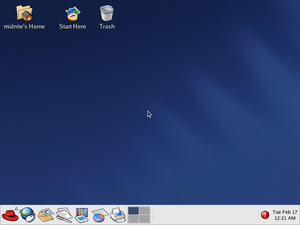
Back ريدهات لينكس Arabic Red Hat Linux Azerbaijani Red Hat Linux Bulgarian রেড হ্যাট লিনাক্স Bengali/Bangla Red Hat Linux Catalan Red Hat Linux Czech Red Hat Linux Danish Red Hat Linux German Red Hat Linux Greek Red Hat Linux Esperanto
 | |
 GNOME 2.2, the default desktop on Red Hat Linux 9 | |
| Developer | Red Hat |
|---|---|
| OS family | Linux (Unix-like) |
| Working state | Discontinued |
| Source model | Open source |
| Initial release | May 13, 1995 |
| Final release | 9[1] |
| Package manager | RPM Package Manager |
| Kernel type | Monolithic (Linux) |
| Userland | GNU |
| License | Various |
| Succeeded by | Red Hat Enterprise Linux, Fedora Linux |
| Official website | www |
Red Hat Linux was a widely used commercial open-source Linux distribution created by Red Hat until its discontinuation in 2004.[2]
Early releases of Red Hat Linux were called Red Hat Commercial Linux. Red Hat published the first non-beta release in May 1995.[3][4] It included the Red Hat Package Manager as its packaging format, and over time RPM has served as the starting point for several other distributions, such as Mandriva Linux and Yellow Dog Linux.
In 2003, Red Hat discontinued the Red Hat Linux line in favor of Red Hat Enterprise Linux (RHEL) for enterprise environments. Fedora Linux, developed by the community-supported Fedora Project and sponsored by Red Hat, is a free-of-cost alternative intended for home use. Red Hat Linux 9, the final release, hit its official end-of-life on April 30, 2004, although updates were published for it through 2006 by the Fedora Legacy project until the updates were discontinued in early 2007.[5]
- ^ "Red Hat Linux 9 Features Latest Open Source Technologies".
- ^ "Free Versions of Red Hat Linux to be Discontinued". fusionauthority.com. Archived from the original on 2012-02-07. Retrieved 2008-03-02.
- ^ "History of Red Hat Linux". Retrieved 2018-07-14.
- ^ "The Truth Behind Red Hat/Fedora Names". smoogespace.com. Retrieved 2018-07-14.
- ^ "The Fedora Legacy Project". fedoralegacy.org. Archived from the original on 2013-09-05. Retrieved 2008-03-02.